Stimulating isn't it. I recently came off the hard stuff and I've missed it ever since. I used to see coffee as a real treat, but that caffeine hit may soon be harder to come by. Scientists predict a drastic decline in suitable coffee growing land by up to 60% before 2050. In the show we'll put you in the hotseat to see how well you really know the UK's second favourite hot beverage. In the news: a shake up at CERN could spell big changes for particle physicists universally, dinosaurs with coloured feathers and the happy hormone that makes old timers love life...
In this episode
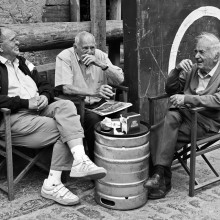
01:21 - Why are senior citizens more social?
Why are senior citizens more social?
Paul Zak, Claremont Graduate University
Oxytocin is the brain's hug hormone. It helps us bond with our babies and lovers and makes us more inclined to trust others. Interestingly, as Claremont Graduate University's, Paul Zak, has been showing the older we get the more of it we make and this he speculates means we tend to be happier with our lot. As we grow older, it also means we feel a stronger urge to connect with others. Bearing this in mind, our own James Tytko experienced the sudden urge to call someone very special to him...
James' Grandmother - Hello?
James - Hi grandma. How are you?
James' Grandmother - Who? I'm all right.
James - It's James.
James' Grandmother - I know James, how are you?
James - I just wanted to call to see how you were.
James' Grandmother - It's very nice of you James. Thank you very much.
James - No, no worries at all.
James' Grandmother - I'm not too bad, but you don't sound like James.
James - Why'd you say that it would be because I'm on the studio microphone, probably. Paul Hacken his team have been showing that as you age your brain trains to release more oxytocin and through further reinforcement from positive social interactions, you have further desire for these behaviors. I asked him how they managed to show this.
Paul - Many neuroactive chemicals like testosterone, estrogen decline with age. We want to see what the release of oxytocin would do. So we measured the change in oxytocin, in blood, after a short video, people aged 18 to 99, and then related that change in oxytocin to a variety of behaviors to understand not only is the release changing with age, but is it affecting behavior? And in fact, we found that the older people were, the more oxytocin they released and the more helping behaviors they engaged in.
James - You said you were showing a video to a hundred people. What exactly was the video? And how did you know that it was a sort of oxytocin inducer.
Paul - There's a video we've studied extensively in my lab for the last 15 years, and many other people now have used it as well. It's a really consistent way to induce the brain to make oxytocin. There's a video of a father and his two year old son, the son's dying of brain cancer. It's super sad. It's very sweet and warm. And then we gave people in addition a chance, since we were torturing them by drawing their blood, we paid them. We give them a chance to donate some of the earnings to the research hospital that had produced the video. Then we went further, but we also looked at the change oxytocin related to previous prosocial behaviors. In this case in the last year, how much people had donated money, time and goods to charity. And it's the first time we've shown the acute production of oxytocin is related to retrospective prosocial behaviors. And that's important because it tells us that the change in oxytocin may in fact, be tuning up based on your previous history of behavior. In other words, you can train your brain to release more oxytocin by engaging in more helping behaviors. So there's a key takeaway here for, for younger people or people of any age, which is if you have a habit of connecting to others, of helping others, then you're training yourself potentially to be a better oxytocin releaser. The more you release oxytocin, the greater satisfaction in life people have.
James - We've just gone past Easter and and pass over, Ramadan's still ongoing. So do you find that your work is sort of consistent with these religious traditions?
Paul - I think religious traditions have survived for thousands of years because there's some ancient wisdom captured by them. And what we're finding here is the underlying neurologic basis for that ancient wisdom, which is that we can live more fulfilled, happier, more satisfied lives by being a service to others. Oxytocin does a couple of interesting things in the brain. It reduces physiologic stress. So that means we have potentially better cardiovascular fitness. It also improves the immune system. So by serving others, by connecting to others, we're actually improving our own mental health, but physical help as well.
James' Grandmother - You hear that now James?
James - I do hear you.
James' Grandmother - I could smack your bottom.
James - You could.
James' Grandmother - I could James.
James - Only if I deserved it. I hope.
James' Grandmother - So. Goodbye then James behave yourself.
James - I will do have a nice day.
James' Grandmother - God bless James. Bye bye, dear.
Harry - Wasn't that really sweet James Tytko grandmother there. James was also talking to Paul Zak that study was published in the journal Frontiers in Behavioral Neuroscience.
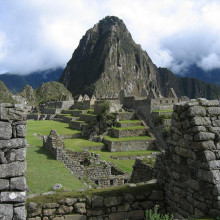
06:14 - The Inca and antidepressants
The Inca and antidepressants
Dagmara Socha, University of Warsaw
The Inca people appeared in Peru around 800 years ago. They notoriously practised human sacrifices high in the mountains. In recent years the bodies of some of these children have been discovered, and owing to the extremely low temperatures and dry air, they have been well preserved. So well preserved, in fact, that things they were eating and drinking at the time they died have been preserved too. And that includes plants with known medicinal qualities, including agents that give relief against altitude sickness, and substances that cause euphoria and relaxation. Speaking with me, Harry Lewis, from the University of Warsaw, Dagmara Socha…
Dagmara - Inca sacrificed many things to God, including the textiles, food, and the object that they value and think were precious like the gold silver objects, but also children and women, they would bring them from long distance to have them and sacrifice them for the gods because they were more precious, even more than gold or silver.
Harry - Is this something that would happen on an annual basis or, or how frequent would a ritual like this occur?
Dagmara - Incas make the sacrifice when something important happened in the Inca empire. So when the new heir of the throne had been born or the Inca ruler was sick or died, or also they make it for the important places in their empire, like for the high mountains or Pilgrim center. And then they make it also, when something important happens, like there was an earthquake or eruption of the volcano.
Harry - And you managed to get your hands on a couple of these, I suppose you'd call victims. It must be very exciting to get something that's so precious. So what can you do with it? What can you find out when you get a sample from one of these victims?
Dagmara - We know from previous research that Incas give to the children and young women leaves from the coca and some of mommy still have tbe rest of the leaf inside the mouth. Chewing of them help with altitude sickness, but we also want to check if Inca gives something else to this victim. And the second was the Ayahuasca beverage. In this case, we actually find the trace of consumption of lianas called Banisteriopsis caapi, they're growing natural in Amazonnia forest. And they are a main component of this Ayahuasca beverage.
Harry - That particular plant in the beverage, what purpose could it serve by being given to the victims at the end of the ritual?
Dagmara - Generally the modern Ayahuasca is obtained from two plants. One of them is the liana that I mentioned called Banisteriopsis caapi and the active alkaloid is harmine. The most important property of this plant is that it's an anti-antidepressive. Today the harmine is also used for anti-addictive treatments.
Harry - This must be one of the first examples of humans using antidepressants.
Dagmara - Actually we have some trace of the consumption of harmine in previous studies, from the mommys from the regular death, but we didn't know why it was given. And here we have the clear information that for the Inca it was important to ensure the good mood of the victims. So giving them antidepressive plants could be clearly an intention for this kind of purpose. And it's also the first evidence for using, by Incas, antidepressive plants. And also probably the oldest case known to date.
Harry - And that paper really was fantastic to read Dagmara Socha and her research was published in the jounral Nature.
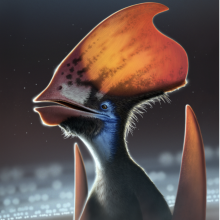
10:48 - Colourful dino feathers
Colourful dino feathers
Maria McNamara, University of Cork
'Fluffy feathers' is probably not what springs to mind when thinking about dinosaurs; but based on fossil records, at least some dinosaurs are thought to have had plumage, and most likely colourful plumage too. Now scientists think we can add another prehistoric creature to the feathered list: pterosaurs. A specimen of one of these flying reptiles shows feather-like sprays issuing from its head, and, by looking at very high magnification, the University of Cork’s Maria McNamara has been able to pick out structures called melanosomes, that would have held the melanin pigment that gives skin and the feathers of modern birds their colour schemes. She took Julia Ravey through the findings…
Maria - Pterosaurs were flying reptiles. They ruled the air at the same time that dinosaurs were roaming the land, and they had long leathery wings, short legs, and some had enormous head-crests.
Julia - And when I think of flying, what comes to my mind is feathers. So did these reptiles have feathers?
Maria - That is the million dollar question. For many years we've known that pterosaurs had an outer coat of some kind of fluffy stuff. Then we rocked the boat a little bit, a few years ago when we reported that we had found branched feathers in two juvenile pterosaurs from China. The style of branching in those feathers was not quite like that of modern birds, the feathers were actually branched in little tufts, but now we found a pterosaur from a different group. And the style of branching in this pterosaur head-crest is much more like the style of branching we see in modern birds because the branches are successive. You know, they're the whole way along the feather shaft. So feathery pterosaurs are a thing.
Julia - Did you find out anything else about the properties of this feathery coat?
Maria - Where things got really exciting was when we put the feather samples under the electron microscope. And we found that they preserve little granules of the pigment melanin. What was very unexpected was the fact that the melanosomes had different shapes in different feathers. So the simple unbranched feathers have real sausage shaped melanosomes, and the branch feathers have shorter egg-like melanosomes. This is really exciting because modern birds do the same thing and they do it to make different colours.
Julia - How does the shape of these melanosomes impact feather colour?
Maria - Depending on the melanosome shape, you can produce, for instance, orange redish, ginger colours. They are produced by ball shaped melanosomes, whereas blacks and dark browns are produced by sausage shaped melanosomes. This very strongly suggests that those different feathers had different colours.
Julia - If these animals had coloured feathers, what colours do we think these might have been?
Maria - It's difficult to give a precise hue because our current models, which we're using to infer colour aren't as accurate as we'd like. Especially when it comes to trying to figure out how other pigments might influence the colour. Just finding melanosomes doesn't necessarily mean that your feathers were black or brown, but that long bone that sticks out from the back of the pterosaur head, would've had these black unbranched feathers near the head, and then out near the tip it would've had these paler branched feathers. That's our best guess for now.
Julia - If pterosaurs had these, you know, coloured pigmented feathers, what do we think they might have been used for?
Maria - You know, to answer that question, we really would need to get a good handle on the precise colour and on the colour pattern. But because we only have the head, we can't really tell what colour patterns they had. It just tells us that the importance of visual signaling of sending signals to other animals, maybe about your fitness or maybe to attract mates, or maybe for camouflage, how important this is for survival. I guess, you know, we just have to find some pterosaur specimens with feathers distributed over the whole body and start looking at the patterning.
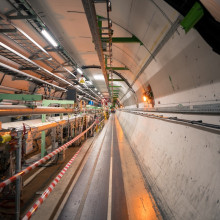
15:07 - The CERN makeover
The CERN makeover
Steven Abel, Durham University
You may have heard that the hadron collider received a recent makeover. This is the large particle accelerator over in Geneva, its circumference is 27km, it’s so large that it straddles France and Switzerland. Here to tell us about the revamp is Steven Abel. Professor of mathematical and theoretical particle physics at the University of Durham...
Steven - So the LHC is a proton proton collider. What we do is we accelerate protons to extremely high energies and we collide them together and sort of pick over their wreckage, basically in order to hope to find things that we don't expect to find, maybe find new things. Since it began, maybe two decades ago, it's just been confirming what we think about the early universe, the nature of matter, and reproducing things from the early universe that we expect.
Harry - At the moment, we've seen in the news that there's been these improvements made to the structure. What are those improvements?
Steven - It's kind of incremental. It's increasing its luminosity as we call it: the intensity of the beam, the number of collisions - we want to increase them as much as we can in order to get more data basically. We're always trying to get as much data as possible because the things we're trying to test and the things we're trying to look for are extremely rare. In order to see those things, to test them, you have to have a huge number of collisions.
Harry - With this coming in, scientists are getting quite excited. What are they excited about finding?
Steven - There wouldn't normally be so much excitement with this sort of upgrade, I don't think, but it's because it seems as if we're on the kind of cusp of finding something completely new. Up to now, we've had something called the standard model, really since the early seventies. That model has described everything to a sort of ridiculously good extent. It's one of the most tested models imaginable.
Harry - And that's the particles, is it, in the standard model? It's a list of what we would see?
Steven - That's right. So, the standard model contains within it, of the fundamental forces of which so far there are four, three of them. Gravity doesn't appear there. Plus, there are matter particles. The matter particles are quarks, and there are six flavours of quarks. They all have different properties. And six flavours of leptons. Leptons are like electrons inside a proton. Then there wll be three quarks.
Harry - And is it thought that the experiments that could come out of CERN at the moment, then, might challenge this well solidified standard theory.
Steven - That's right. A B quark is quite a heavy quark. Occasionally, you produce them, so maybe one in a million collisions will produce a B quark, which decays in a certain way to, say, two electrons, or two muons. Plus something which is called a strange quark. Those particular sorts of decays are showing things which we do not expect in the standard model. They're showing that the muons are behaving differently from electrons. That's called a lepton non universality, and that is not an ingredient of the standard model. So, that's a complete surprise. The reason people are excited is, if you look at one of these things, it wouldn't be so out of kilter, but we're seeing that there's quite a few of them which are all pointing in the same direction. What people are hoping for in the next run is that we're going to get enough data so that we're going to be able to say that this is now something which is definitely not the standard model. We're definitely seeing something new and we can throw away the standard model, finally.
Harry - It feels like it could be a massive shake up for particle physics.
Steven - It'll sort of be the only game in town for a while. Everyone will have to think about what on earth is going on, where does it fit into a larger theory? Eventually, it could have some sort of ramifications for, for example, fifth forces. There's a possibility that there's an additional force, or new particles could be producing this effect, called leptoquarks, that's another idea. It could, ultimately, be the start of changing our perceptions about how everything is arranged.
Harry - Steven, are you expecting to see this come to fruition over the next year or two?
Steven - You're now asking me to place bets. What I think is, we are close enough that it will in this run, it will be confirmed in a sort of technical sense.
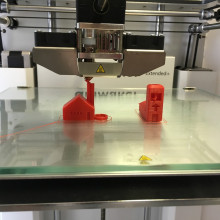
20:01 - Laser focused 3D printing
Laser focused 3D printing
Tracy Schloemer, Stanford University
3D printing - or additive manufacturing - has revolutionised engineering. We can make and test designs for bespoke objects quickly and cheaply. Rolls-Royce recently even began printing hard-to-manufacture parts for some of their jet engines this way. But there are limitations: you have to build up your object layer by layer, which means some structures are still tricky to make: like one object that needs to be inside another object, for instance. Now scientists have come up with a clever solution, both literally and metaphorically: they have a light-sensitive fluid that “sets” when light of a certain colour shines on it. “But, surely, wherever the light shines through you’d get a line of set material!,” I hear you cry. No, because as Stanford University’s Tracy Schloemer explains to Robert Spencer, she’s come up with a material that contains particles that convert a different, inactive, colour of light to the critical colour that sets the material. This means you can control the setting process and make objects inside objects, like the miniature boat she showed Robert…
Robert - Tracy, I'm looking at this picture and it looks like something out of The Office. There's this small item in a piece of jelly. What is it? What are we looking at?
Tracy - It is not a joke from Dwight Schrute. It is a boat that I have printed and used light to pattern on the inside of the jelly, or jello, as we would call it in the States.
Robert - This is a 3d printed boat that you've put into this solution. How did it get there?
Tracy - What I did is I used a laser, focused down, and then that's absorbed by a molecule in the jello. That allows for me to print.
Robert - Okay. It's one of these curing resins, like people might be familiar from nail gels or dental work?
Tracy - Yes. Except we made it ourselves.
Robert - So it needs light in order to set?
Tracy - Correct. And a very specific wavelength of light as well. So, when I shine the red light at it, it doesn't necessarily work right away. We have to have a certain power density to generate this blue light.
Robert - So why can't you just shine blue light into it?
Tracy - When you shine blue light at it, that blue light gets absorbed at the surface. So, I wouldn't have been able to print benchy deep within that vat of jello, I would have only been able to print benchy from the surface, and I would have had to move the resin up over time.
Robert - We should probably clarify, benchy is the little boat in there.
Tracy - Benchy is the adorable little boat. Yes.
Robert - You've managed to print this by focusing this blue light inside the resin. But, you say you can't just shine blue light because then it sort of prints at the surface. So, how did you get the blue light into the resin if you can't shine blue light onto the resin?
Tracy - We generate that blue light in situ or inside of that resin. We have some very special molecules that can convert red light into blue light. And we can do that really quite precisely.
Robert - Does that mean that you've imbued this resin with the special molecules that you've designed? How does that work?
Tracy - Yeah. What we do is we have these special molecules and we encapsulate them. If you're familiar with the drink boba, it's like we have these tiny little nanometer size boba beads, and they're so small that can't see them directly with your eyes. The resin, the jelly still looks clear, but we have those embedded in the resin. We can generate that blue light by focusing the red light really well on those boba beads and that's how we're able to do it.
Robert - So you focus this red light and then suddenly there's this flash of blue light at the point where all the focusing comes together.
Tracy - Yes, it's really cool. We can use an LED and that's much lower power than using a laser.
Robert - We've seen similar kinds of technologies before, similar light cured manufacturing. What sets this apart from the existing things that you can buy off the shelf?
Tracy - Off the shelf, if you have a spare couple million US dollars, you can buy a nanoscribe, and you're going to be able to get really, really good resolution, but you're stuck with really tiny volume. We can print a thousand times larger than that. We can print at much lower powers. We can print faster. To be fair, our technology isn't commercially available yet.
Robert - Where else is it going? This ability to take lower frequency light and upscale it to higher frequency light. Does that have any uses beyond making cute boats?
Tracy - Yes, but it is a huge challenge. How do we get high energy light precisely where we need it? Imaging optogenetics, drug delivery, where you have to use low energy light to go beyond the surface of your skin. Maybe we have a drug we want to deliver but we need yellow light to trigger it to release in the body. Well, how can we generate that high energy light beneath the surface? We can use these up conversion nano capsules that we've developed.
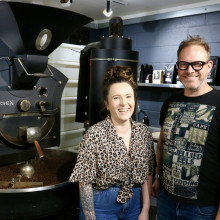
26:60 - The artisan coffee revolution
The artisan coffee revolution
Simon Fraser & Emily Davalle, Hot Numbers Coffee Roasters & James Hoffmann
We’re talking about your cup-of-joe. This discussion is fully inclusive, we aren’t going to be snobbish about it either, it doesn’t matter if you like it black, strong, instant, peruvian or even served ice-cold. At The Naked Scientists we’ve noticed a rise in supermarket coffee prices in recent months, and Harry Lewis thought it was about time we topped up our knowledge on the beverage before looking to its future...
Harry Lewis - If we are gonna talk about coffee, I should start by introducing you to the biggest coffee drinker that I'm know.
Harry's Dad - Oh. Thanks.
Harry - That's not wrong to say. Is it? That's pretty accurate.
Harry's Dad - Yeah. That's not wrong to say. I do love a coffee.
Harry - How many coffees do you have a day?
Harry's Dad - 4 or 6.
Harry - 4 or 6?! I thought you cut it down to 1.
Harry's Dad - No, I've gone back up again. I cut back for 2-3 months, but 4 has been pretty standard for me.
Harry - Have you noticed a change in the price of it over the years?
Harry's Dad - Yeah. The coffees I get, what they do is they cut down the pods. Prices stay the same, but where they used to buy for example, 16 pots for £3.50 some manufacturers now are doing 12 or £3.50. There's one that still does 16 at the moment, which I'm sticking with. But I do know that they are about to go up again because there's a shortage of coffee beans coming out, of the field. The bad harvest.
Harry - Dad's right. This year's coffee production in Brazil is expected to be down 23% from 2020 due to frosts and droughts. Experts predict that it's gonna get even more difficult to forecast coffee production in Brazil due to increased flooding. I'm also willing to say that my dad is right on record because I checked his facts with someone who knows.
James - Hi, my name is James Hoffman. I've worked in coffee for nearly 20 years now. I've started a coffee company. I've written a book called The World Atlas of Coffee and I also make YouTube videos all about coffee too.
Harry - James tells me that coffee prices have been on the rise for years.
James - There's definitely been a rise in price. Coffee is definitely suffering at the hands of the challenges of global logistics right now and I think just the cost of doing business say in the UK has gone up, wages have gone up, everything's gone up. As well as people trying to build sustainable businesses after one of the most difficult periods of trading in living memory.
Harry - Feels like a runt that quite a lot of people are gonna have to bear, because there's an awful lot of us in the UK that like coffee.
James - Yeah. We're a medium coffee drinking country. We're not a hardcore coffee drinking country, like the Scandinavians; They drink 4x as much coffee per capita as we do. We're about 1/2 of the Americans or the Italians. We're a reasonable coffee drinking country, but we're not super serious.
Harry - What is it about it that we love so much? What keeps us coming back for more?
James - I don't think we can deny caffeine remains the primary driver of coffee consumption. But I think a lot of people have made a leap from having a very transactional relationship with caffeine where 'I will drink this thing and I will feel alert, awake, productive, whatever it's gonna be' into 'I will do that for, for those things, but I'll have a good time along the way.' I think people have seen coffee now as an opportunity for deliciousness. I can get the chemical hit in a really pleasant, enjoyable, interesting way and I think that's really changed our relationship with it.
Harry - And I'm sure you've seen it. There definitely has been a boom in artisan coffee production. I've driven just outside Cambridge to what must be this city's favorite coffee house. It's called Hot Numbers. I'm gonna meet Simon and Emily. It's here that they dream up their aromatic concoctions, which are made purely from arabica coffee. That's one of the two most commonly consumed species. I think we want to know how it's possible in this day and age to get so many products from one single type of bean.
Simon - Let's roast some coffee. We got 12 kilos of Brazil here. Now let's see. I've had all the cherries, et cetera, removed. See here, Harry, it smells kind of grassy, like straw.
Harry - The roasting process plays a pivotal role in the flavour of the final product. Simon's let us join him for the 9 to 12 minutes that it takes.
Simon - Now we're gonna drop the coffee in. The big cast-iron drum is pre-heated. You drop the massive coffee, which instantly cools the temperature on the probe and then it slowly heats up. The roast profile will look like a tick. Once we get a profile we like, we can dramatically change the taste of this coffee. The air flow, the temperature and the time will have dramatic effects on the coffee and also you can get an incredible amount of variety from different countries and the way they grow their coffee, the altitude they have, the way they farm them, and the soil.
Harry - Let's pop over to the shelf and have a look. Over at the shelf, there's all of the Hot Numbers coffees, and they've got a huge variety of flavours. There's also Emily and she has a surprise in store for me.
Emily - We are going to test some of the coffees that we've got here. We're gonna start off with the Roger Chilcon, which is a Peruvian coffee. This is growing at medium altitudes above sea level; about 1,900 - 2000 meters above sea level. I won't tell you what flavours out of this. If we have a go and see what you can figure out.
Harry - Needless to say, I was absolutely useless
Emily - For me, it's more like grapefruit. It hits the sides of my tongue. It coats my mouth and I can really get grapefruit out of this one.
Harry - Maybe for the naive tongue of mine. We could compare it to something else.
Emily - Absolutely. This is actually my favorite coffee. It's the el diviso; this is a Colombian coffee. It's grown in varying altitudes. This is slightly lower than the first one, so we should be getting a lot of different flavors that come through in this coffee.
Harry - Up on the wall, Simon and Emily have this Specialty Coffee Association's flavour wheel. It looks like a chemistry textbook illustration; a big circle where you can help yourself identify the flavours you experience with all these different colours shooting off. When you hear Emily say that this tastes like grapefruit, well, she's using the technical language derived from world coffee research. Me on the other hand, not so much.
Harry - It's completely different.
Simon - Isn't it? It's dramatically different.
Harry - That initial hit is quite sweet so it still tastes quite fruity in that sense. It's just the after-taste is so drastically different from that Peruvian coffee.
Simon - This, I find, is quite boozy. It's quite, you know, fermented fruit. That's a lot to do with the processing method as well as how ‘the natural process’ works.
Harry - What does that mean, Emily?
Emily - The natural process is the oldest method of coffee processing and it takes 3-6 weeks to complete this process. After the cherries have been harvested, they're laid out in a thin layer and they're dried in the sun. This is either done on brick patios or some of them used raised drying beds. These are really great because it gets circulation around the whole coffee cherry.
Simon - Because that fruit's in context for such a long time, that's what gives it that boozy fermented taste.
Harry - Literally everything seems to affect the flavour. Back over whilst we're roasting, Simon tells me that washing the bean, drying it, transporting it, especially grinding it, each little component tweaks and changes the final outcome of that cup of coffee.
Simon - Now what we are doing is we are putting on the cooling drum. We've got a rotating arm here, we're just about to drop the coffee out and gonna cool it down. It's like a giant cullender and it's sucking air through this so when the beans are dropped, they don't carry on roasting. It cools it as fast as we can.
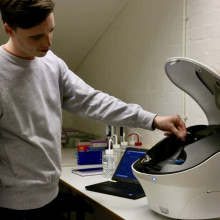
36:35 - How much caffeine is in your cup?
How much caffeine is in your cup?
Jonathan, Cambridge University & James Hoffmann
Just how much caffeine is too much? Harry Lewis' father drinks four mugs of the stuff a day, is that too much?
James - That's a good question. When it comes to caffeine consumption, there are broad guidelines out there. And they'll say for an adult male, it's 300 milligrams of caffeine a day. The tricky bit is that you don't know how much caffeine is in the cup of coffee that you're drinking right now. You don't know how much coffee is in the raw coffee beans. You don't know how good a job you've done of getting the caffeine out of the beans, but I would say 4 cups of coffee, if it's good, quality coffee will take you around 300 - 350 milligrams. Cheaper coffee has a higher caffeine content so if it's three cups of instant coffee you're probably there quite comfortably.
Harry - Caffeine has historically had it pretty bad in the press. But research suggests that moderate coffee consumption, anywhere between 2-5 cups a day could be more healthful than harmful. It's been linked to a lower likelihood of type-2 diabetes, heart disease, liver cancer, Parkinson's disease and depression; seeing as it stimulates dopamine pathways in the brain. If that's the case, what are the negatives of drinking coffee?
James - I think that the primary issue is gonna be sleep and I think we understand more and more about the importance of sleep. Good quality sleep is essential for health in a way that I don't think we truly understood until relatively recently. If caffeine is interrupting your sleep, it really is a problem that has long lasting and serious health effects and I think it's definitely one to worry about. I think we've probably been a bit blasé historically about our conception of caffeine and tied it into feeling productive and getting the job done and all of that kind of stuff. I think that's the first big indicator. Different people genetically do deal with caffeine differently. There are slow caffeine metabolizers and there are fast caffeine metabolizers, so the half life of caffeine in your body will vary based on your genetics. There's no single hard and fast rule.
Harry - There are subsections of the population that this rule doesn't really apply to. The story is a little different, for example, in pregnant women. For this cohort, there's a reduced recommended intake. It's less than 200 milligrams of caffeine a day; That's on average, roughly 2 cups. That's because high caffeine consumption is associated with complications, including miscarriage and stillbirth. Maybe we should know how much caffeine differs between each mug of coffee we drink. With that in mind, I took it up with my friend, Jonathan in the chemistry department at Cambridge University.
Jonathan - You've made me read up on this topic quite a lot, and I actually appreciate it because it's quite interesting once you get into the nitty gritty of it. It's interesting that in the year 2022, people still debate on how best to get the caffeine out of the coffee. Very timely, we're very timely indeed.
Harry - Here's the plan. I have 3 samples of espresso and hopefully we're gonna see if there is a difference between brands in caffeine concentration. Now, if we were to do this to the highest standard, Jonathan says we would need hazardous chemicals and some pretty skilled expertise. I've managed to twist his arm and drop quite a lot of that scientific scrutiny, but bear in mind, he really did not give in willingly.
Jonathan - The way we split these samples up is we'll make sample number 1 to be Hot Numbers, which is a local coffee shop. Sample number 2 will be a large scale coffee chain, and sample number 3 will be another local coffee shop. The first thing that we do is we will make a dilution of these because the coffees are quite dark in colour and we want them to be as translucent as we can these solutions in order to get our light through them eventually.
Harry - We're using a pretty fancy bit of kit. It's a UV spectrometer. What does a UV spectrometer do?
Jonathan - With this we can basically shine some light through a liquid and we can see at what wavelength of light the particles in this liquid absorb or emit.
Harry - Right. I'm assuming that the more of this molecule, in our case caffeine, there is the more...
Jonathan - …bigger, the absorbance of light will be at that wavelength. Yes.
Harry - And we'll see that on this computer here.
Jonathan - Yes. That will look like a peak. Like a mountains.
Harry - In goes sample 1, sample 2, and finally sample 3. In fact, I've told a bit of a white lie, because we actually did run a lot more tests. Mainly because Jonathan was attempting to refine our results, by the end though, we were left with 3 graphs representing our three espressos.
Jonathan - With samples 1 and 3, we see generally that they show higher levels of absorbance at the wavelength that we would expect caffeine to absorb at.
Harry - And then with sample two, what do we see?
Jonathan - Sample 2 shows a lower general absorbance at that specific wavelength, which could suggest that there's less caffeine in that sample than the other two.
Harry - From the data that we've got, it's not perfect by any stretch of the imagination, but we have an absorbance of 0.4 for sample 2, and for samples 1 and 3 it's 1.4 and 1.5 respectively. It's 3x bigger. Maybe 4x bigger, almost.
Jonathan - Sample number 2 came from a big chain coffee house, whereas samples number 1 and 3 were from local coffee shops.
Harry - Now our experiment isn't precise. It would probably start a brawl over at a peer-reviewed journal. That's because we didn't extract the rest of the gubbins from the coffee, due to us needing those dodgy chemicals. When the light shines through our sample, it is possible that some of the rubbish left behind in the coffee is absorbed at the same wavelength as caffeine. In short, we need to take our results with a large pinch of salt. But our results do make sense as James explains.
James - Historically, you've seen a bunch of studies done on the British high street, coffees from all the major chains and really quite broad caffeine levels, found in those drinks big variations from relatively low to really surprisingly high because caffeine is not a simple thing. It exists in nature primarily as an insect repellent. The higher you grow coffee, the less need there is for the plant to produce caffeine. Unless you know the altitude that your coffee was grown at, it's hard to make a very good guess that the caffeine content, different species produce different caffeine contents. Then in the brew process, caffeine's highly water soluble, but if you don't do a great job brewing the coffee, you won't actually get all the caffeine out. If you do an incredible job brewing the coffee, you'll get a little bit more. All of these things come together into pretty large variations for the kind of consumer experience.
Harry - Historically the coffee industry has been really opposed to putting caffeine measurements on their products. In part, it must be somewhat down to the difficulty when trying to extract caffeine. It also must have something to do with the massive variation between each batch of coffee beans. I think it's pretty fair to say that we haven't got a clue how much caffeine is actually in there and maybe we should know. It does seem particularly important for some members of the population, like pregnant women.
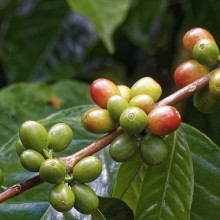
44:18 - Coffee and climate change
Coffee and climate change
Dr. Roman Grüter, Zurich University of Applied Sciences
Coffee has exploded onto the supermarket shelf and the high street, but it looks like this tasty stimulants growth may be a thing of the past. Harry Lewis hears from Dr. Roman Grüter at the Zurich University of Applied Sciences, talking about his recently published work in PLOS, outlining the expected suitability of coffee in the near future....
Roman - The biggest producers of arabica are in Brazil, but also several countries in South America. I think the limits today are about 27 degrees north and south of the equator. You can find it in many places in India, Eastern Africa, but also in Southeast Asia.
Harry - What does the future of arabica look like over the next 20 - 30 years?
Roman - What we found in our study was that arabica coffee might be negatively affected by climate change. It's very difficult to say when and where it might not be possible to grow coffee arabica anymore. But what we could clearly find in our study is that we have to expect a decrease of suitable areas for growing arabica globally in the range of 30 - 60% by 2050. This is quite a drastic decrease. However, I have to stress here that there are also possibilities for climate change adaptation in these coffee aggro-ecosystems which might have the potential to partially offset some of these negative changes.
Harry - Would I be right in thinking that as the temperature changes, it's obviously happening all over the globe, some areas might become less suitable for growing coffee, but that means that some areas might become more suitable for growing coffee that you couldn't previously do it before?
Roman - Exactly. This is also the other extreme that we could find in our studies, or there are certain areas that might become more suitable for growing arabica. Mainly higher altitudes and latitudes, but compared to the areas decreasing, this is a much smaller area of land that might become better suitable for coffee.
Harry - Is this something you're quite worried about? Is this something that you feel is pretty inevitable?
Roman - Yes, I am worried about this and maybe not about the fact that it might get more expensive to drink coffee in the future or coffee might get less available, but I'm more worried about the fact that a big number of smallholder farmers who are really depending on these and selling this crop, they really get under pressure. They need alternative crops, ideally that can still be grown in their agricultural systems, but also they need support for adaptation strategies. By the state or by organizations working in this field.
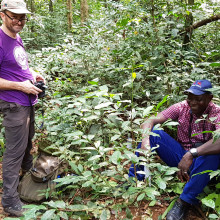
47:41 - On the hunt for a new species of coffee
On the hunt for a new species of coffee
Dr. Aaron Davis, Kew Gardens
Coffees' future appears pretty bleak. That's in the words of someone who has traveled the world to document it. Dr. Aaron Davis, the senior research leader of 'Crops in Global Change' at Kew Gardens, who explains his work to Harry Lewis...
Aaron - Unlike many of the things that we either eat or drink, coffee is a perennial crop. It's a tree crop. It has to be in the ground for many, many years. It's not like an annual crop, like rice or wheat, where you can simply replant every year. If your crop is destroyed, let's say by drought, then you have to replant and it takes 4 - 5 years to get your crop back. That is, that's a huge issue for all farmers, particularly smallholder farmers.
Harry - Aaron says that farmers find themselves in this position could be encouraged to move to new locations where the conditions are more favourable, alter their practices, or try out a new species of coffee.
Aaron - All 3 scenarios require effort and investment. However, unless we do something about greenhouse gas emissions, none of those adaptation pathways will make any difference. Our main focus is changing the coffee crop itself. We don't want farmers to shift from coffee to another crop because that also creates difficulties. If you look at the coffee species that we drink, we drink 2 robusta arabica, however there are another 128 coffee species out there in the wild. What we are doing is we are looking at some key candidates that can be used to develop climate adapted crops rather quickly because we don't have a lot of time. That's, that's the other aspect to all this.
Harry - What are those coffees and what are their attributes that give them that potential?
Aaron - We are looking at coffees that have 'market potential'. When I say 'market potential', what I mean is coffees that are acceptable and desirable to consumers. What we've seen in the past are the production of coffees that were very good in terms of their farming attributes, high yield, disease resistance, etc, but the consumers didn't want to buy them because they didn't taste very good. In fact, some of them tasted quite awful. We are learning from those mistakes of history in that respect to find something that really satisfies consumer demand.
Harry - What were those species called?
Aaron - At the moment we are looking at 2 species in detail. One of those is stenophylla coffee. That's from west Africa. That's a really interesting species because it has 'a superior flavour'. It tastes like high quality arabica. The other main attribute is that it's extremely heat tolerant. It will crop and yield successfully at temperatures that are around 6-7 degrees Celsius higher than arabica that's the average mean temperature. The downside with stenophylla is it's a low yielder. We would work on that to try and improve yields and that's exactly what we're doing at the moment. I didn't mention the other species, which is liberica coffee. There we've got something that is heat tolerant, and it may be somewhat drought tolerant, we're doing those investigations right now. But what it does have is an extremely high yield and farmers really like growing it.
Harry - Aaron, you said you are off on what sounds a little bit like a, not to sensationalize it, but an Indiana Jones expedition for coffee. What does that entail? Is that literally dropping yourself where you think there's gonna be a new species or an old species that might fit the bill, hoping you find something.
Aaron - It's a bit more structured than that. In the past, I've been doing this for over 20 years, we were really just going to all the unexplored places in Africa and Madagascar, trying to understand how many species of coffee there were and what the diversity was like in the wild. Now we're more focused, we're going to specific places, looking for specific species with particular attributes that we think could be used for crop development. We are looking for shortcuts. We are looking at the long game, but we're also trying to get things into the supply chain as quickly as possible.
Harry - I mean, are there examples of places where this is becoming commercially viable? Is this something where these 2 species that you've spoken of realistically could take off?
Aaron - Yeah. We are working with Clifton Coffee over in Bristol and we're about to import a large volume of liberica from Uganda. That will go into the supply chain this year. In Sierra Leone, we're not that advanced, we're just at the planting stage. In Sierra Leone we only refound stenophylla at the end of 2018-2019. We've been building up stock, this year the planting will start, and then within 4 years we'll see the first crops. The idea is to get it into shops and cafes but also, perhaps more importantly, is to provide an approved coffee income for farmers and Sierra Leone.
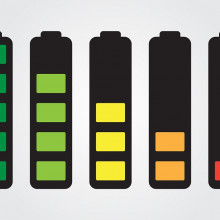
54:07 - QotW: Does potential energy have mass?
QotW: Does potential energy have mass?
It's commonplace to describe batteries as full or empty depending on their charge. So surely it to make sense for them to get heavier. Right? Dr. Israel Temprano from the Univserity of Cambridge explains to Otis Kingsman about this battery baffler...
Israel - Potential energy is a term in physics related to the distance that a certain mass has to in any potential well. This relates to how high an object is. If you have an object that is standing very, very high and you let it go, it will start moving. Then it will trade its potential energy to kinetic energy. That's not how we store energy in batteries.
Otis - It turns out these are two very different questions Tibor. The potential energy of objects held up doesn't give it any extra mass. But then what happens when we charge a phone battery?
Israel - The common batteries that we use in our everyday electronic devices, is what we call a lithium-ion battery. lithium-ion batteries work by just moving lithium ions, which are positively charged lithium atoms, from one side of the battery to the other. AA on AAA batteries, they have a different architecture inside, but again, all you're doing is moving components from one side of the battery to the other.
Otis - As the ions move to the other side of the battery, electrons move out of the battery and into the phone where it generates electricity before going back into the battery but on the opposite side.
Israel - In order to balance the charge, electrons have to follow these ions. What we do is force these elections to go outside of the battery. This is why we call this type of battery, 'a rocking chair', because we're just moving things from one side to the other. It's this movement of electrons that we use to power our portable devices.
Otis - When we charge a battery, we are moving the electrons out of the device and into a wire before electrons go back in on the original side of the battery that it started on. This resets for battery, and the process can start all over again. Overall, there will always be the same amount of electrons and ions within the battery.
Israel - So no. When you charge one of these batteries, all you're doing is moving components from one part of the battery to a different part of the battery.










Comments
Add a comment